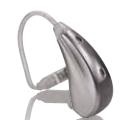Interview with Elizabeth Galster, AuD, Research Audiologist, Starkey Hearing Technologies
Carolyn Smaka: Thanks for your time today, Dr. Galster. Before we get in to Xino Tinnitus, can you tell me about your background, and your role at Starkey?

Elizabeth Galster: I’m a research audiologist in Clinical Product Research here at Starkey. The clinical product research group is responsible for performing clinical trials, primarily with products before release. Sometimes our trials are focused on a specific feature or technology that we want to incorporate into a product line. At other times our studies are a global evaluation of a new product that we are looking at introducing to the market. In terms of my background, I completed my undergraduate degree at the University of Iowa and my Au.D. at Vanderbilt University where I worked in the Dan Maddox hearing aid research lab. I worked as a research assistant under Dr. Todd Ricketts and worked on a few studies investigating hearing aid algorithms. I also spent some time working at the VA in Nashville, and from there I came here to Starkey. I have been here for almost five years.
Carolyn: What was your role with Xino Tinnitus?
Elizabeth: I’ve been involved with Xino Tinnitus from the very beginning of the development process. I had an interest in tinnitus and was part of the team that came up with the vision for the product, and helped to design it. From there I conducted the clinical trial, and also was involved in the development of some of the supporting materials. It was a unique role for me because I got to be involved from very early on in the development process up through the product launch and post launch support. It has been very exciting.
Carolyn: You mentioned the initial vision for the product. What were some of the reasons for bringing this to market?
Elizabeth: Starkey has a history with tinnitus, but it had been a while since Starkey had a tinnitus treatment or therapy product on the market. Starkey was interested in getting back into that area and supporting clinicians who work with patients who have tinnitus. From the beginning, one of our primary goals was to develop something that was flexible, for a couple of different reasons. We know that there are a wide variety of treatment approaches ranging from partial masking to total masking to Tinnitus Retraining Therapy and Progressive Tinnitus Management, and others. We also know from the literature that there is great variability across tinnitus patients themselves and what they experience and need out of a sound therapy program. Our goal was to develop a very flexible solution that could be used with most tinnitus treatment approaches, and also meet the varied needs and preferences of both professionals and their patients.
Carolyn: Can Xino Tinnitus be used for sound therapy as well as a hearing instrument?
Elizabeth: Yes. In addition to its Multiflex Tinnitus Technology, Xino Tinnitus is a fully featured hearing aid. The key features include Voice iQ2, our fast-acting noise reduction algorithm, and Spectral iQ, our frequency lowering algorithm. It is a small, cosmetically attractive receiver-in-the-canal product that appeals to a great deal of people.

Figure 1. Xino Tinnitus receiver-in-the-canal product.
Carolyn: Tell me more about Multiflex Tinnitus Technology.
Elizabeth: Multiflex Tinnitus Technology refers to the tinnitus technology, or sound therapy feature. As I mentioned, our goal in developing Xino Tinnitus was flexibility, and as the name implies, Multiflex Tinnitus Technology incorporates that in a number of different ways. It features 16 bands that are adjustable for shaping the noise signal. The default setting after performing a Best Fit is a white noise, but the professional can shape that noise based on patient preference. The modulation parameters of the noise are also flexible, based on patient preference. The noise is capable of being both amplitude and frequency modulated over time, and the professional can set the rate of modulation. In our clinical trials we observed that different patients had different preferences. Less than half of the patients preferred modulation off. Over half of the patients preferred modulation on, but their preferences for the settings of that modulation, whether the rate was fast, medium or slow, was split.
Carolyn: Is there any fitting advice as to which patients preferred which setting? Did you see any trends?
Elizabeth: Through the clinical trial, we allowed patients to try each of the modulation settings, and we did not see a way of predicting what rate of modulation patients would prefer, which was interesting. That goes back to the idea that these tinnitus patients are varied in their needs and preferences, and it is important to offer flexibility because we do not necessarily know what will be best for each individual at the outset.
Carolyn: A few years ago when SoundPoint was just coming to market, I had a great discussion with Harvey Abrams about it, and I see that SoundPoint can also be used with Xino Tinnitus.
Elizabeth: Yes, it can. Although there are many specific treatment approaches for tinnitus, we do recognize that there are lots of professionals who are not intimately familiar with these approaches, and they may not treat tinnitus patients every day. We wanted a tool to assist the professional in the fitting process. Also, we see the advantage of involving patients in the fitting process and allowing them to take ownership of their tinnitus and of the sound therapy process by contributing to the fitting of Multiflex Tinnitus Technology.
SoundPoint is an interface that is integrated into our fitting software. It allows the patient to explore various settings for the shape of the noise generated by Multiflex Tinnitus Technology. The patient listens to the devices and makes adjustments in real time as they move their mouse around the screen or move their finger around on an iPad screen. It allows them to actively participate and listen to a wide variety of settings - certainly more settings than a professional would be able to program for a patient. The patient can then make a selection based on his or her experience listening to the signal generated by the hearing aids or device.

Figure 2. SoundPoint patient navigation screen.
Carolyn: It sounds like a methodical way to compare settings, similar to what an optometrist does with A/B comparisons with lenses.
Elizabeth: It’s a great way to get the tinnitus patient involved in the fitting. These patients often have a hard time describing what their tinnitus sounds like or what they experience. Rather than introducing guesswork and trying to translate what the patient is trying to communicate, SoundPoint allows the patient to experience it instead. There was a recent study that found that patients have difficulty describing their tinnitus (Eggermont, 2012). We can take away some of that difficulty and simply give them an interface that allows them to listen and determine which settings are most comfortable and provide relief.
Carolyn: How do patients access the sound therapy in Xino Tinnitus?
Elizabeth: The professional can set it up in the memories to best meet the patient’s needs. For example, one memory might be set to provide amplification only. One memory could be configured to have both amplification and Multiflex Tinnitus Technology. One memory could be set up with only Multiflex Tinnitus Technology and not amplification. The patient has a switch to control the memories.
Carolyn: Excellent. When you are talking about SoundPoint preferences, have you found any cases where patients’ preferences with the sound therapy change over time? As they get more acclimatized, do they then want a different signal or different level of the signal?
Elizabeth: We have not looked at acclimatization or changes in preference over time, but there were several patients in the clinical trial that liked having different settings available to them via different memories. There were several patients in the clinical trial that had a memory with the steady-state signal without modulation for certain times of day and then another memory with modulation because a number of the patients reported that the modulation was relaxing. They would use a memory with modulation of the Multiflex Tinnitus Technology signal when they were reading a book or sitting down in quiet environments, but there were other times of day when they preferred a steady-state signal for the Multiflex Tinnitus Technology.
Carolyn: That is interesting; I would not have even thought of that. What were some of the other things you learned in the clinical trial?
Elizabeth: We conducted a clinical trial at the Starkey facilities to look at preferences for the settings of the Multiflex Tinnitus Technology and benefit with the product as well. We enrolled 19 participants in the study. Eighteen of them had hearing loss and one had normal hearing. All of them had clinically significant tinnitus as defined by the Tinnitus Handicap Inventory. Participants wore the devices for a six to eight week period, which is relatively short for a tinnitus study, but I can talk more about another long-term study. We used both the Tinnitus Handicap Inventory and also the Tinnitus Functional Index, which is a newer questionnaire that was developed by Meikle and colleagues and published in Ear and Hearing in 2012. Both of these measures assess tinnitus handicap or severity.
When looking at preferences for Multiflex Tinnitus Technology settings, we found three patients during the study preferred a memory with amplification only. That is not necessarily unexpected because of the variability that is seen with tinnitus treatments and tinnitus patients. There were 16 who preferred memories with Multiflex Tinnitus Technology enabled. Among those, preferences of self-chosen SoundPoint settings or settings that were programmed by the research audiologist based on our Best Fit settings were split pretty evenly.
We also looked at modulation. As I mentioned earlier, just under half the subjects preferred modulation off, and over half preferred modulation on. Preference among those who preferred modulation on was split pretty evenly across the slow, medium, and fast settings. In looking at benefit from the technology, we asked patients at the end of the study to report the degree of change in their tinnitus, in addition to completing the questionnaires that I mentioned. The scale ranged from: worse, no effect or no change, mildly better, moderately better, or significantly better. Of the 19 participants, we found that 11 not only reported that their tinnitus was better to some degree, but they also exhibited a clinically significant improvement on at least one of the questionnaires during the course of this 6 to 8 week field trial.
Carolyn: You must have been surprised by that, because six to eight weeks is not a long time for some of the approaches.
Elizabeth: It was certainly a positive outcome and a higher success rate than we were expecting for such as short trial. It was comparable to the literature in terms of other studies that evaluated similar products. Many of those studies have taken place over a much longer period of time, however. Our success rate in a 6 to 8 week period was comparable to that of longer 6 to 12 month field trials.
Carolyn: Now that the product is launched, is the research complete, or are there studies still under way?
Elizabeth: There are studies currently under way. Since that initial study which took place before product release, there has been another study where we worked with five different audiologists throughout the country that have each fit the product on four to six of their patients. We have received their feedback and their patients’ feedback on the product. In addition, we are working with the National Center for Rehabilitative Auditory Research (NCRAR) and Jim Henry’s team in Portland, Oregon. We are supporting a study with them that is looking at use of Xino Tinnitus with Multiflex Tinnitus Technology over a longer period of time. That study is currently under way, and we are expecting that data collection to be complete later this summer.
Carolyn: That is exciting, and a prestigious group to partner with for research.
Elizabeth: They have certainly done quite a bit of work in tinnitus. They developed Progressive Tinnitus Management and were in involved in the development of the Tinnitus Functional Index.
Carolyn: Is the clinical trial available for professionals who want more details?
Elizabeth: Yes, there two white papers on Xino Tinnitus available on starkeypro.com. One covers the product itself, and the other is the clinical results.
Carolyn: It seems like more and more companies offer a tinnitus solution today. What makes Xino Tinnitus unique?
Elizabeth: I think SoundPoint is what stands out relative to other products on the market. It enables an opportunity for clinicians to involve the patients in the fitting process and assume ownership over their tinnitus and the sound therapy process. Certainly no one knows a patient’s tinnitus better than that patient.
Carolyn: Starkey is offering a lot of great courses on tinnitus on AudiologyOnline, including some with noted tinnitus expert Dr. Rich Tyler. It’s nice to see that support for professionals.
Elizabeth: We know that support is very important when working with hearing aids, and maybe even more so with tinnitus and tinnitus patients. Tinnitus patients can be some of the more challenging patients that we work with as audiologists, and Starkey recognizes the importance of supporting professionals. Our job is not just to provide a device, but also providing resources to better equip the professional to manage these patients when they come into their offices.
Carolyn: I’ve never worked with tinnitus patients myself, but I’m told they are indeed the most challenging, but also the most rewarding. Improving tinnitus has been described by patients as giving them their life back.
Elizabeth: Yes. We have seen some of that in the clinical trial. It was a rewarding experience for me to work with these patients in the trial and see the impact that this product was having on their lives.
Carolyn: That’s nice to hear. Thanks so much for discussing Xino Tinnitus, and we look forward to following up for an update when the other studies come to fruition.
Elizabeth: That would be great, thanks Carolyn.
For more information, visit Starkey HearingTechnologies.com or the Starkey Expo Page on AudiologyOnline.
References
Eggermont, J.J. (2012). Current issues in tinnitus. In K. Tremblay & R. Burkard (Eds.), Translational perspectives in auditory neuroscience (pp. 123-163). San Diego, CA: Plural Publishing.
Meikle, M. B., Henry, J. A., Griest, G. E., Stewart, B. J., Abrams, H. B., McArdle, R., et al. (2012). The Tinnitus Functional Index: Development of a new clinical measure for chronic, intrusive tinnitus. Ear and Hearing, 33(3), 153-176.

